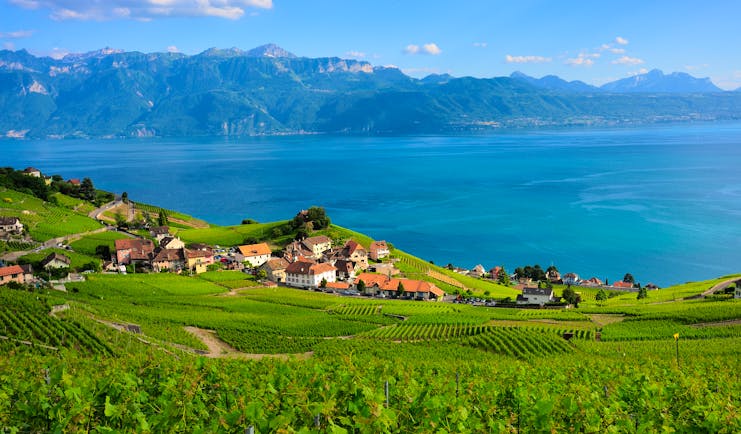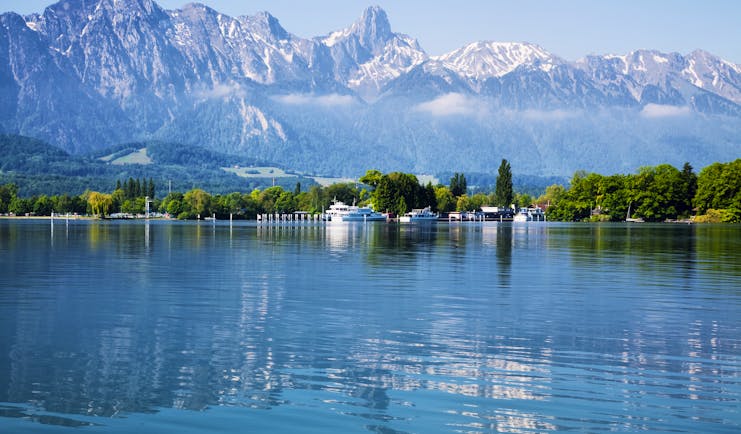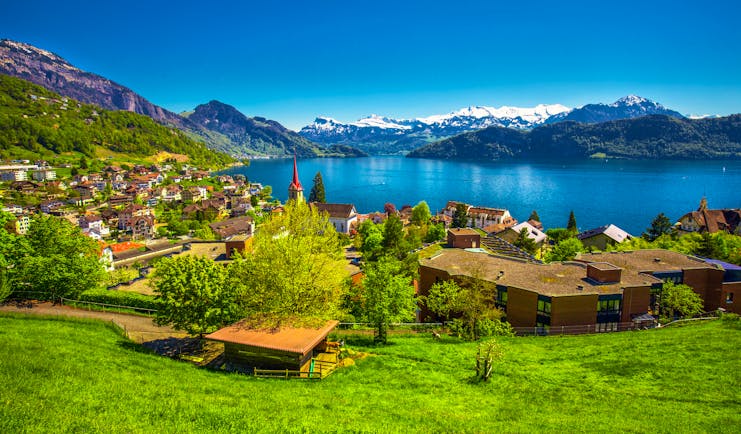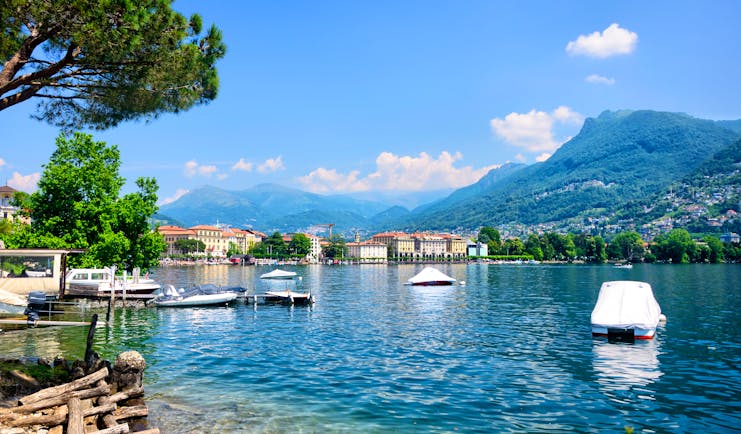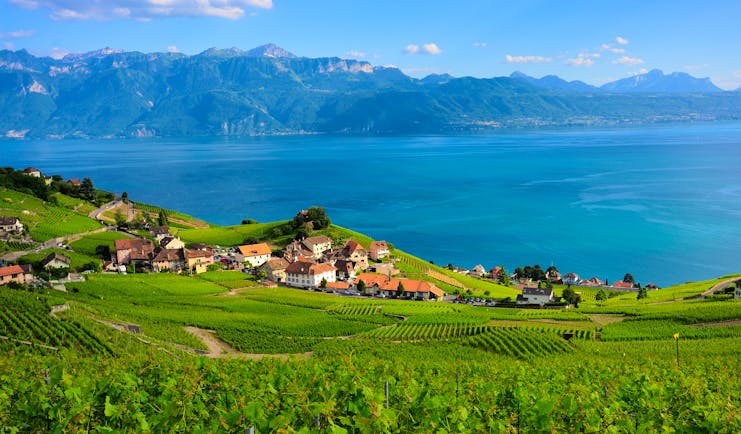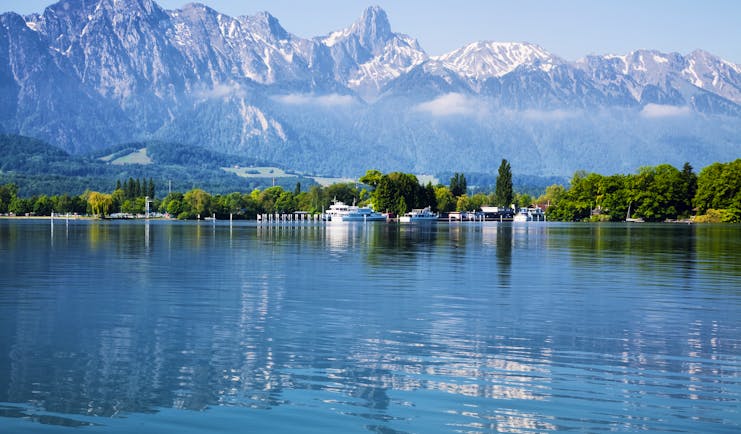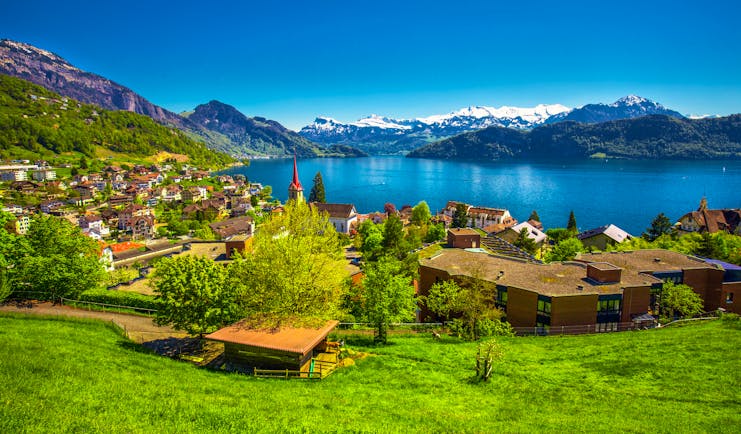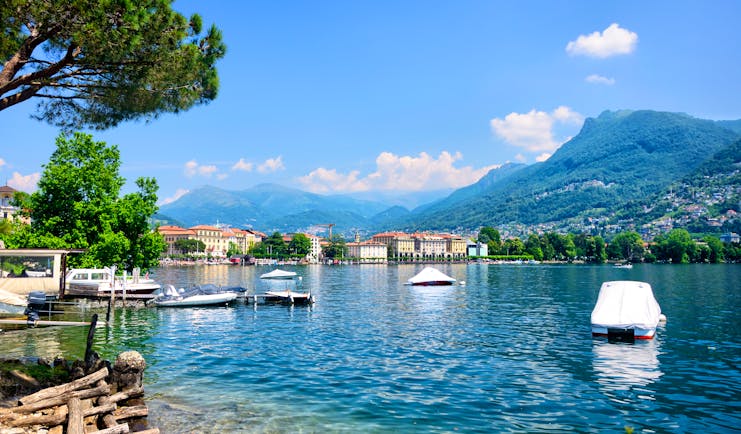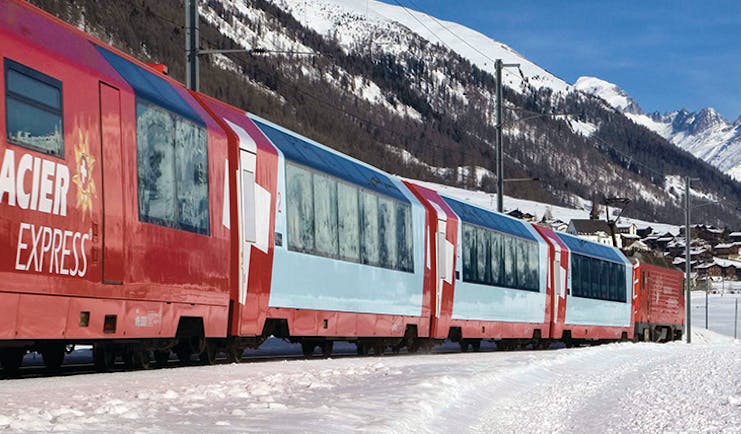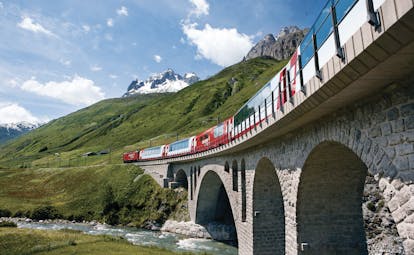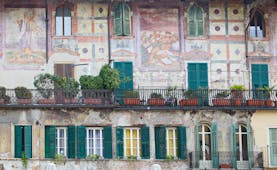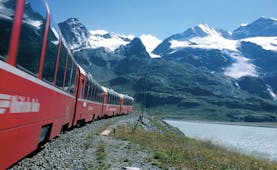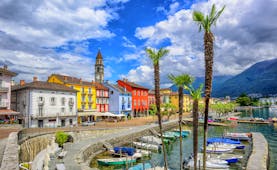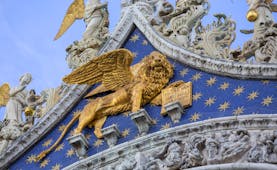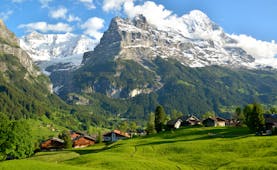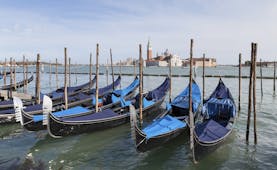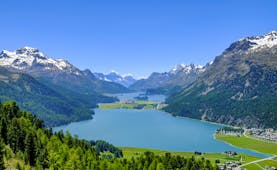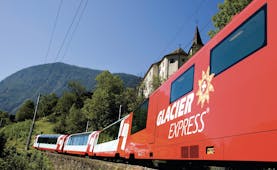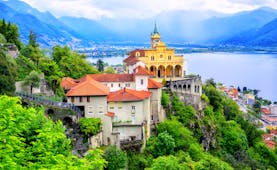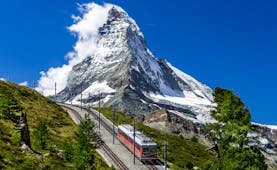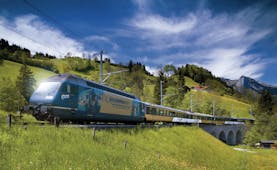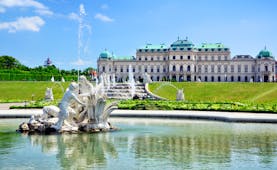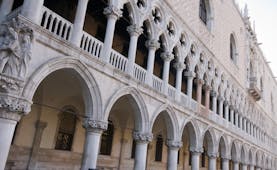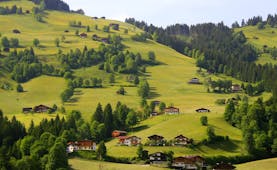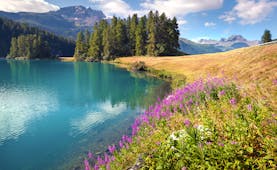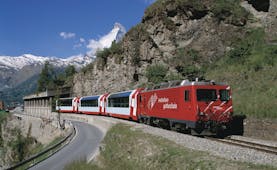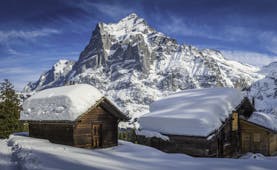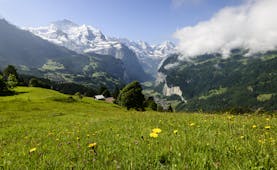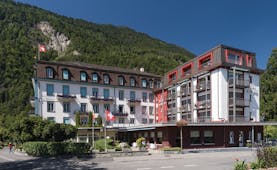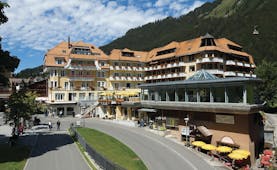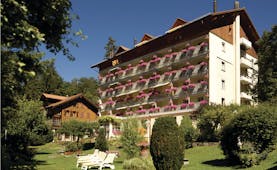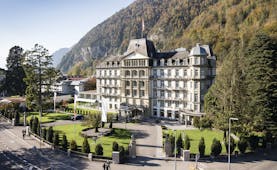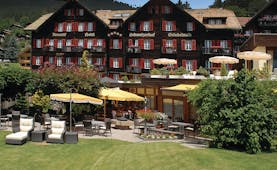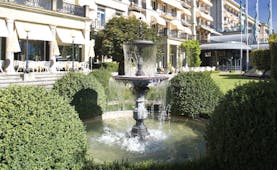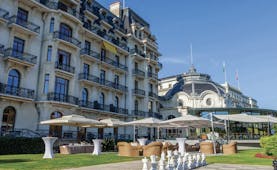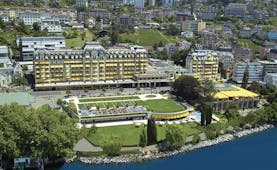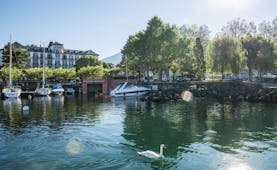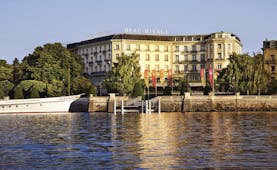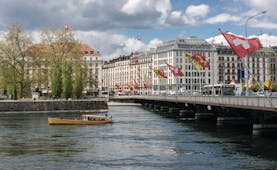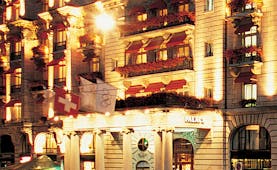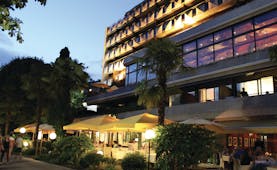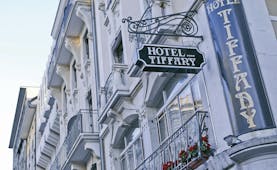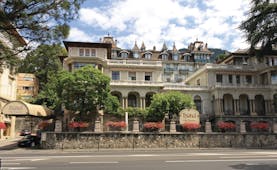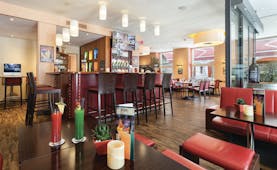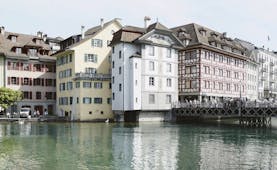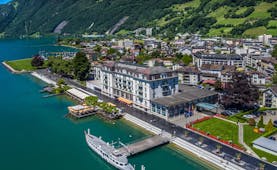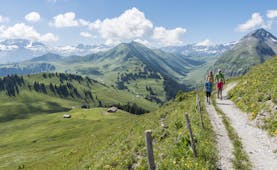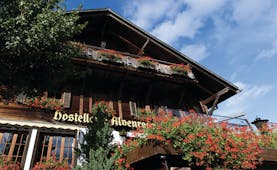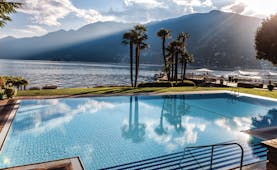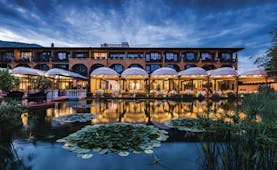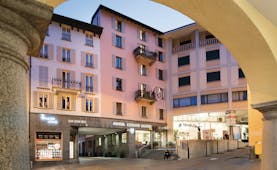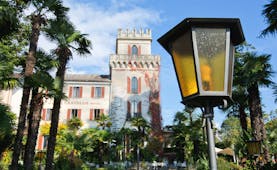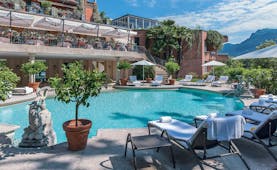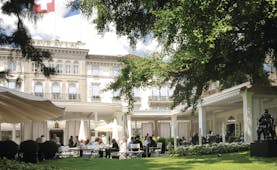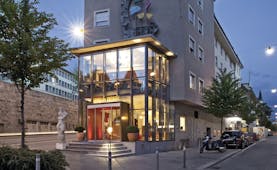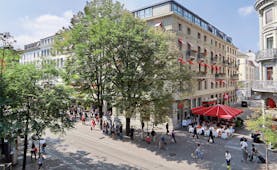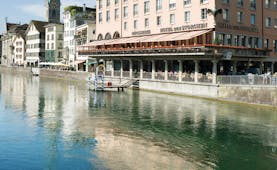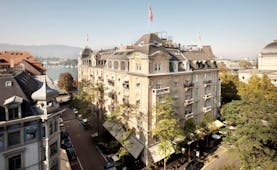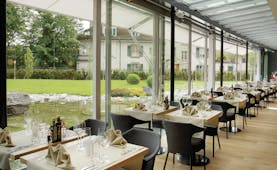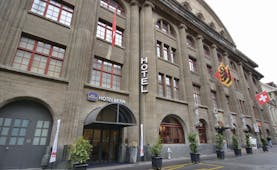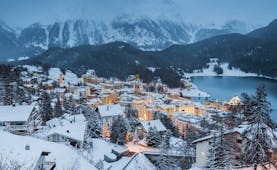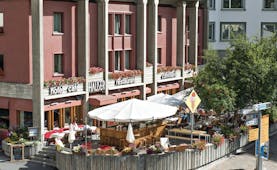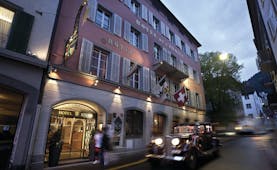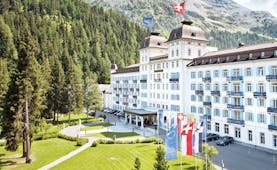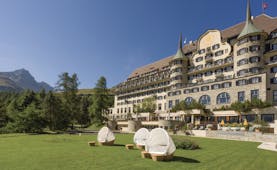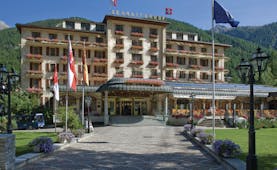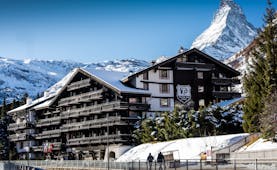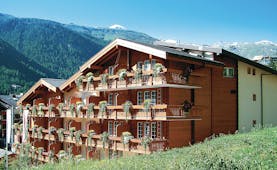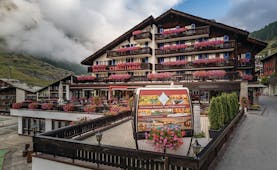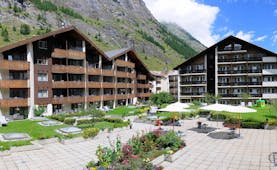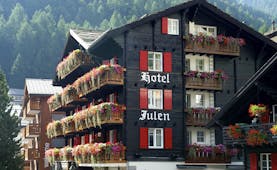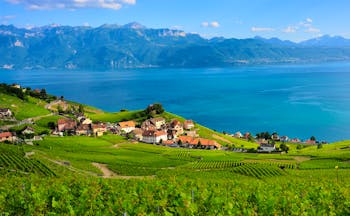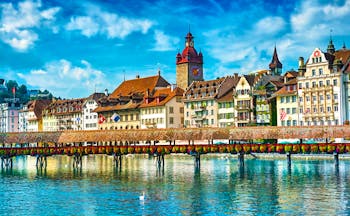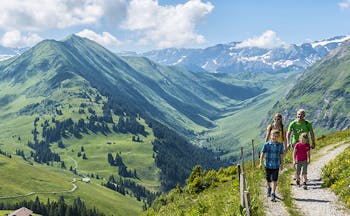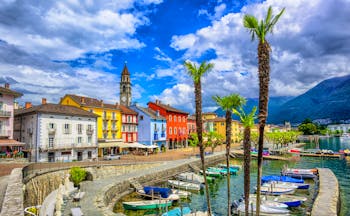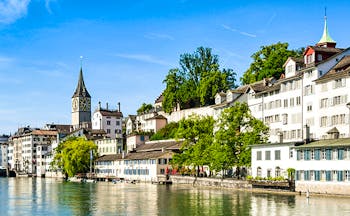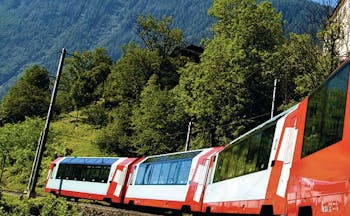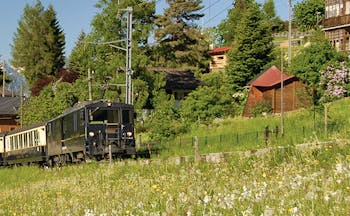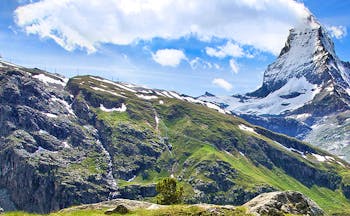Luxury Swiss grand touring holiday by train visiting the lakes of Switzerland with journeys on the scenic iconic trains
This 11-night grand tour of Switzerland’s lakes begins with your arrival by plane or by train into Geneva. From here, you catch a train to Lausanne for your first stay beside Lake Geneva, one of Switzerland's best known lakes. Then, move on into the Bernese Oberland via the GoldenPass Line and stay in the chocolate-box village of Grindelwald. This is the perfect opportunity to ascend the Jungfrau by rail to Jungfraujoch, the highest railway station in Europe. Next, this tour takes you north via spectacular Interlaken to Lake Lucerne. Take in the impressive cultural sites, including the Chapel Bridge, the Water Spike, and the Water Tower. Enjoy a lake cruise, from which you can view the many picturesque villages that line the shores. Board the Gotthard Panorama Express boat to Fluelen from Lucerne, and then the Gotthard Panorama Express train from Fluelen to Bellinzona, and then on to Lugano. Enjoy the Mediterranean feel of Ticino, exploring the nearby mountain peaks as well as the colourful city itself. Then, you join the Bernina Express as the dedicated coach takes you across northern Italy, past Lake Como to Tirano on the Italian border. Board the Bernina Express train here and journey north to St Moritz at the foot of the Suvretta Mountain, and just a stone’s throw from many picturesque lakes. You now re-join the Bernina Express railway as it heads towards Chur, the oldest town in Switzerland, where you change for a direct train to Zurich. Relax in your choice of luxury Zurich hotel after visiting the Grossmunster Church and appreciating the crispness of this historic area before returning to the UK by air or rail.
Highlights
Lake Geneva • GoldenPass Line • Saanenland • Bernese Oberland • Lake Lucerne • Gotthard • Gotthard Panorama Express • Lake Lugano • Bernina Pass • Bernina Express • Lake Zurich
Day by day
Travel by rail or by air from London to Geneva on your first day. Perhaps spend an hour or two exploring the city, home to fine watch-making, the headquarters of the UN, and the Jet d’Eau fountain. Wander around the Vielle-Ville, stopping at the St Pierre Cathedral. From Geneva, catch a train along the northern shore of the lake to Lausanne. You stay here for two nights.
During your time in Lausanne, choose from its many elegant attractions; seek out the impressive historic monuments as well as the new, modern additions. Lausanne Cathedral is believed to be one of Europe’s most beautiful Gothic monuments, crowned by spires of unusual purple and orange hues. An Olympic Museum has been opened in the heart of Lausanne’s Old Town; three levels depict Olympic history in all its colourful grandeur. Next to the museum is the Olympic Park, dotted with works of art, sports sculptures, and well-maintained flowers and trees. The promenade at Ouchy is a must, especially for an evening stroll. The promenade takes you from the gardens of the Olympic Park along to the Haldimand Tower, the Bellerive Swimming Pool, the Chateau d’Ouchy, and the port. Enjoy dinner in the atmospheric location of Ouchy port before returning to your hotel.
The next leg of your journey takes you to the eastern point of Lake Geneva, in Montreux, home to Chillon Castle, Switzerland’s most popular historical monument. In Montreux, change trains to the GoldenPass Line and zig-zag your way up to higher ground as you begin the journey to Grindelwald in the Bernese Oberland. The distinctive golden carriages of the GoldenPass Line take you first through the villages above Montreux, where the houses become sparser and have more individualistic architecture. Pass the turquoise waters and wooden bridges of Montbovon and enter Saanenland in Chateau d-Oex, where the mountain chalets begin to become more prominent. Emerge from a gently curving valley into the flat plains around Gstaad that are formed by the convergence of five valleys. Ascend to Schoenried, and then to Zweisimmen, the so-called ‘gateway’ to the Saanenland. The landscape here becomes jagged as severe bluffs and mountain peaks burst out of areas of thick, rich forest. The Stockhorn Rock between Boltigen and Erlenbach im Simmental marks your entrance to the Bernese Oberland. Pass through flourishing natural beauty in the Nature Park of Diemtigtal and trace the shores of Lake Thun before you reach Interlaken, where you change trains for Grindelwald. The journey takes around three hours in total, bringing you into Grindelwald in the early afternoon. You spend two nights in Grindelwald.
Grindelwald is an enchanting chocolate box village, scattered across the gentle green slopes of the Lutschine Valley. The nearby village of Wengen, accessible via two cable cars, by bus, or by train, sits at the base of the Jungfrau. Your stay in Grindelwald is therefore perfectly placed for enjoying the most iconic attraction of the Bernese Oberland. Travel by funicular railway up to Jungfraujoch, the highest railway station in Europe, to appreciate the stunning views. For hiking trails, take cable cars up the Monch and the Eiger, or simply follow the softer trails that lead out of Grindelwald. The picturesque Lake Fallboden makes for idyllic and relaxing afternoon and evening walks. Complete or begin your stay in Grindelwald with a self-guided stroll between the rustic wooden chalet houses.
Leave Grindelwald at about midday, changing trains at Interlaken, to arrive into Lucerne at around 3pm. This journey takes you along the extension of the GoldenPass line, a scenic journey past many of the sparkling lakes of central Switzerland. You spend three nights in Lucerne.
An essential visit on any stay in Lucerne is the Chapel Bridge, the city’s main landmark and the most photographed monument in Switzerland. Walk along the bridge, taking in the views of the Reuss River, the so-called Water Spike, and the Water Tower. For both historical significance and architectural beauty, visit the 17th century Jesuit Church, which overlooks the water and is topped by two droplet-shaped domes. Above the city is the Musegg Wall, a 14th century structure that once protected the city within. Though the city now sprawls outside of this wall, the nine defensive towers remain, three of which are open to the public.
On your second day in Lucerne, perhaps enjoy lunch in a pavement café on the Kornmarkt Square, beside the colourful Pfistern Guildhall, the Hirschenplatz Square, or the Weinmarkt Square, where Lucerne swore its federal oath with Schwyz, Uri, and Unterwalden. To see some exemplary Swiss culture, visit the prestigious KKL Luzern gallery, the Rosengart Collection of works by Picasso and Klee, the Wagner Museum in Tribschen, and the Swiss Museum of Transport. Finish your days with a sumptuous dinner back at your hotel, or in one of Lucerne’s many gourmet restaurants.
Heading south, you adopt a different form of transport to cross Lake Lucerne. The Gotthard Panorama Express begins with either a salon motorboat or a steamboat, which docks at various places mentioned in the legend of the Swiss National Hero of Liberty, Wilhelm Tell. See the site where Tell reputedly jumped from the bailiff’s ship before pushing it and its crew back into the stormy lake waters, and the meadows of Rutli, where Friedrich Schiller set his popular recounting of the tale. When you reach Fluelen, perhaps take the time to wander along the narrow promenade that separates the harbour from the lake, before boarding the Gotthard Panorama Express train on your way to Lugano. Here, the railway track runs along the Reuss River, across wide, flat valleys until the track gains altitude and chocolate box villages dot the hillsides. Navigate the Gotthard Loop Tunnels, passing through the complex rail network of Goschenen, and entering the province of Ticino at Airolo through the Gotthard Strassentunnel. The train now follows the River Ticino past the waterfalls of Biasca, the Italianate architecture of Faido, and the historic solitary chalets. When you reach Bellinzona, disembark for the train to Lugano. This is the most Italianate town in Switzerland, distinctive because of its three medieval castles that stand on hilly bluffs and form a united UNESCO World Heritage Site. The journey from Bellinzona to Lugano is an incredibly short one, bringing you into Lugano at around half two in the afternoon. You spend two nights here.
Use your time in Lugano to explore this cultural lakeside town, which is quintessential of the Ticino region. Lugano’s Old Town will be one of the highlights of your stay here, with its relaxed café culture influenced by both the Italian border and the prominent Swiss towns to the north. Pay a visit to the Cathedral of Saint Lawrence, which sits at the top of the gently stepped Via Cattedrale. This Roman Catholic cathedral was founded in the Middle Ages but was drastically rebuilt in the late 15th century. Its tower still rises high above Lugano, crowned by a distinctive green dome. For a further, more rounded, insight into Swiss cultural history, visit the waterside pink-fronted Museum of Cultures. Lake Lugano is perfect for a final sweeping boat trip, or for sampling the local water sports. The peak of nearby Monte Bre can be reached by funicular railway from Casserate, from where you can take in the sublime views, seek out the forested beauty spots, and embark on a hiking trail. San Salvatore can also be reached by funicular railway from Lugano, and offers an alternative, but no less stunning, perspective.
You depart Lugano by yet another mode of transport: the Bernina Express coach. The Bernina Express bus from Lugano to Tirano in Italy leaves at around 10am, arriving three hours later and passing Lake Como and the picturesque villages of northern Italy on its way. In Tirano, you have an hour to enjoy the charming combination of Italian architecture and Alpine backdrop. Perhaps stop off at the Santuario della Madonna di Tirano on the central square or seek out the historic monuments and paintings dotted around the town. Then, embark on the final part of your Bernina Express journey, ready to arrive into St Moritz two hours later. This stretch takes you past thriving orchards and vineyards, over the unique Brusio viaduct as it spirals back on itself to compensate for the changing altitudes, and into Le Prese over the Swiss border. Continue through the Bergamo Alps, through grand and regal Poschiavo and the Val Poschiavo, passing Alp Grum, the only restaurant to be exclusively accessible by rail. The Bernina Express now begins its ascent to the highest point on the Rhaetian Railway in Ospizio Bernina. Before arriving into St Moritz, you will pass two of the most famous sights on this railway: the Montebello Curve and the Morteratsch Glacier. The Curve itself allows you plentiful time to appreciate the views of the glacier. Arrive into St Moritz in Switzerland, perhaps using your time here to reach the best viewing point of the Suvretta Mountain by cable car, or to visit Lake Sils, Lake St Moritz, or the windy Lake Silvaplana. The neighbouring mountains, including the Piz Corvatsch, Chantarella, and Corviglia, can all be explored by rail.
We recommend spending the morning in St Moritz and then departing by rail around lunchtime to Zurich via the oldest town in Switzerland: Chur. This route takes you first to Chur, past the Cresta Run in Celerina, the Albula Railway Museum in Bergun, the towering Landwasser viaduct in the Domleschg Region, the popular resort of Davos, the stone bridges and ochre houses of Tiefencastel, and the sublime Ruinaulta, before arriving in the ‘Alpine City.’ Change to a direct train to Zurich, which takes just over an hour and skirts around Lake Walen and Lake Zurich on the way. Stay in a luxury Zurich hotel, perhaps taking a river or lake cruise, enjoying a drink in a Badi-Bar on the lakefront, and climbing to the top of the Karlsturm, one of the Grossmunster Church’s two iconic towers. The oldest district in Zurich, and home to the silk-making industry, is Schipfe; perhaps enjoy the luxuries at one of the bathhouses here or seek out the boat builders’ workshops. Visit the Lindenhof District to see the site of a 4th century Roman Fort as well as Charlemagne’s grandson’s 9th century palace. Complete your stay in Zurich with dinner in an authentic restaurant in the Niederdorf District, a ride on the Little Red Train up to the Polyterrasse, a visit to the Kunsthaus Art Museum, or a walk around the city joining the dots between some of the 1,200 water fountains.
On your final day, enjoy a relaxing morning at your choice of hotel before heading to Zurich International Airport for your return flight or to the station for your rail journey home.
We had the most amazing holiday. We loved the location, hotels, train travel and food. All the trains were well planned and on time.Mrs M, July 2018
Holiday price guide From about £3,380 per person based on two people sharing a double room and including for second class rail travel. First class supplement about £580 per person.
Holiday Code CHBR08
Call us on 01392 441245
Luxury Swiss grand touring holiday by train visiting the lakes of Switzerland with journeys on the scenic iconic trains
Travel by rail or by air from London to Geneva on your first day. Perhaps spend an hour or two exploring the city, home to fine watch-making, the headquarters of the UN, and the Jet d’Eau fountain. Wander around the Vielle-Ville, stopping at the St Pierre Cathedral. From Geneva, catch a train along the northern shore of the lake to Lausanne. You stay here for two nights.
During your time in Lausanne, choose from its many elegant attractions; seek out the impressive historic monuments as well as the new, modern additions. Lausanne Cathedral is believed to be one of Europe’s most beautiful Gothic monuments, crowned by spires of unusual purple and orange hues. An Olympic Museum has been opened in the heart of Lausanne’s Old Town; three levels depict Olympic history in all its colourful grandeur. Next to the museum is the Olympic Park, dotted with works of art, sports sculptures, and well-maintained flowers and trees. The promenade at Ouchy is a must, especially for an evening stroll. The promenade takes you from the gardens of the Olympic Park along to the Haldimand Tower, the Bellerive Swimming Pool, the Chateau d’Ouchy, and the port. Enjoy dinner in the atmospheric location of Ouchy port before returning to your hotel.
The next leg of your journey takes you to the eastern point of Lake Geneva, in Montreux, home to Chillon Castle, Switzerland’s most popular historical monument. In Montreux, change trains to the GoldenPass Line and zig-zag your way up to higher ground as you begin the journey to Grindelwald in the Bernese Oberland. The distinctive golden carriages of the GoldenPass Line take you first through the villages above Montreux, where the houses become sparser and have more individualistic architecture. Pass the turquoise waters and wooden bridges of Montbovon and enter Saanenland in Chateau d-Oex, where the mountain chalets begin to become more prominent. Emerge from a gently curving valley into the flat plains around Gstaad that are formed by the convergence of five valleys. Ascend to Schoenried, and then to Zweisimmen, the so-called ‘gateway’ to the Saanenland. The landscape here becomes jagged as severe bluffs and mountain peaks burst out of areas of thick, rich forest. The Stockhorn Rock between Boltigen and Erlenbach im Simmental marks your entrance to the Bernese Oberland. Pass through flourishing natural beauty in the Nature Park of Diemtigtal and trace the shores of Lake Thun before you reach Interlaken, where you change trains for Grindelwald. The journey takes around three hours in total, bringing you into Grindelwald in the early afternoon. You spend two nights in Grindelwald.
Grindelwald is an enchanting chocolate box village, scattered across the gentle green slopes of the Lutschine Valley. The nearby village of Wengen, accessible via two cable cars, by bus, or by train, sits at the base of the Jungfrau. Your stay in Grindelwald is therefore perfectly placed for enjoying the most iconic attraction of the Bernese Oberland. Travel by funicular railway up to Jungfraujoch, the highest railway station in Europe, to appreciate the stunning views. For hiking trails, take cable cars up the Monch and the Eiger, or simply follow the softer trails that lead out of Grindelwald. The picturesque Lake Fallboden makes for idyllic and relaxing afternoon and evening walks. Complete or begin your stay in Grindelwald with a self-guided stroll between the rustic wooden chalet houses.
Leave Grindelwald at about midday, changing trains at Interlaken, to arrive into Lucerne at around 3pm. This journey takes you along the extension of the GoldenPass line, a scenic journey past many of the sparkling lakes of central Switzerland. You spend three nights in Lucerne.
An essential visit on any stay in Lucerne is the Chapel Bridge, the city’s main landmark and the most photographed monument in Switzerland. Walk along the bridge, taking in the views of the Reuss River, the so-called Water Spike, and the Water Tower. For both historical significance and architectural beauty, visit the 17th century Jesuit Church, which overlooks the water and is topped by two droplet-shaped domes. Above the city is the Musegg Wall, a 14th century structure that once protected the city within. Though the city now sprawls outside of this wall, the nine defensive towers remain, three of which are open to the public.
On your second day in Lucerne, perhaps enjoy lunch in a pavement café on the Kornmarkt Square, beside the colourful Pfistern Guildhall, the Hirschenplatz Square, or the Weinmarkt Square, where Lucerne swore its federal oath with Schwyz, Uri, and Unterwalden. To see some exemplary Swiss culture, visit the prestigious KKL Luzern gallery, the Rosengart Collection of works by Picasso and Klee, the Wagner Museum in Tribschen, and the Swiss Museum of Transport. Finish your days with a sumptuous dinner back at your hotel, or in one of Lucerne’s many gourmet restaurants.
Heading south, you adopt a different form of transport to cross Lake Lucerne. The Gotthard Panorama Express begins with either a salon motorboat or a steamboat, which docks at various places mentioned in the legend of the Swiss National Hero of Liberty, Wilhelm Tell. See the site where Tell reputedly jumped from the bailiff’s ship before pushing it and its crew back into the stormy lake waters, and the meadows of Rutli, where Friedrich Schiller set his popular recounting of the tale. When you reach Fluelen, perhaps take the time to wander along the narrow promenade that separates the harbour from the lake, before boarding the Gotthard Panorama Express train on your way to Lugano. Here, the railway track runs along the Reuss River, across wide, flat valleys until the track gains altitude and chocolate box villages dot the hillsides. Navigate the Gotthard Loop Tunnels, passing through the complex rail network of Goschenen, and entering the province of Ticino at Airolo through the Gotthard Strassentunnel. The train now follows the River Ticino past the waterfalls of Biasca, the Italianate architecture of Faido, and the historic solitary chalets. When you reach Bellinzona, disembark for the train to Lugano. This is the most Italianate town in Switzerland, distinctive because of its three medieval castles that stand on hilly bluffs and form a united UNESCO World Heritage Site. The journey from Bellinzona to Lugano is an incredibly short one, bringing you into Lugano at around half two in the afternoon. You spend two nights here.
Use your time in Lugano to explore this cultural lakeside town, which is quintessential of the Ticino region. Lugano’s Old Town will be one of the highlights of your stay here, with its relaxed café culture influenced by both the Italian border and the prominent Swiss towns to the north. Pay a visit to the Cathedral of Saint Lawrence, which sits at the top of the gently stepped Via Cattedrale. This Roman Catholic cathedral was founded in the Middle Ages but was drastically rebuilt in the late 15th century. Its tower still rises high above Lugano, crowned by a distinctive green dome. For a further, more rounded, insight into Swiss cultural history, visit the waterside pink-fronted Museum of Cultures. Lake Lugano is perfect for a final sweeping boat trip, or for sampling the local water sports. The peak of nearby Monte Bre can be reached by funicular railway from Casserate, from where you can take in the sublime views, seek out the forested beauty spots, and embark on a hiking trail. San Salvatore can also be reached by funicular railway from Lugano, and offers an alternative, but no less stunning, perspective.
You depart Lugano by yet another mode of transport: the Bernina Express coach. The Bernina Express bus from Lugano to Tirano in Italy leaves at around 10am, arriving three hours later and passing Lake Como and the picturesque villages of northern Italy on its way. In Tirano, you have an hour to enjoy the charming combination of Italian architecture and Alpine backdrop. Perhaps stop off at the Santuario della Madonna di Tirano on the central square or seek out the historic monuments and paintings dotted around the town. Then, embark on the final part of your Bernina Express journey, ready to arrive into St Moritz two hours later. This stretch takes you past thriving orchards and vineyards, over the unique Brusio viaduct as it spirals back on itself to compensate for the changing altitudes, and into Le Prese over the Swiss border. Continue through the Bergamo Alps, through grand and regal Poschiavo and the Val Poschiavo, passing Alp Grum, the only restaurant to be exclusively accessible by rail. The Bernina Express now begins its ascent to the highest point on the Rhaetian Railway in Ospizio Bernina. Before arriving into St Moritz, you will pass two of the most famous sights on this railway: the Montebello Curve and the Morteratsch Glacier. The Curve itself allows you plentiful time to appreciate the views of the glacier. Arrive into St Moritz in Switzerland, perhaps using your time here to reach the best viewing point of the Suvretta Mountain by cable car, or to visit Lake Sils, Lake St Moritz, or the windy Lake Silvaplana. The neighbouring mountains, including the Piz Corvatsch, Chantarella, and Corviglia, can all be explored by rail.
We recommend spending the morning in St Moritz and then departing by rail around lunchtime to Zurich via the oldest town in Switzerland: Chur. This route takes you first to Chur, past the Cresta Run in Celerina, the Albula Railway Museum in Bergun, the towering Landwasser viaduct in the Domleschg Region, the popular resort of Davos, the stone bridges and ochre houses of Tiefencastel, and the sublime Ruinaulta, before arriving in the ‘Alpine City.’ Change to a direct train to Zurich, which takes just over an hour and skirts around Lake Walen and Lake Zurich on the way. Stay in a luxury Zurich hotel, perhaps taking a river or lake cruise, enjoying a drink in a Badi-Bar on the lakefront, and climbing to the top of the Karlsturm, one of the Grossmunster Church’s two iconic towers. The oldest district in Zurich, and home to the silk-making industry, is Schipfe; perhaps enjoy the luxuries at one of the bathhouses here or seek out the boat builders’ workshops. Visit the Lindenhof District to see the site of a 4th century Roman Fort as well as Charlemagne’s grandson’s 9th century palace. Complete your stay in Zurich with dinner in an authentic restaurant in the Niederdorf District, a ride on the Little Red Train up to the Polyterrasse, a visit to the Kunsthaus Art Museum, or a walk around the city joining the dots between some of the 1,200 water fountains.
On your final day, enjoy a relaxing morning at your choice of hotel before heading to Zurich International Airport for your return flight or to the station for your rail journey home.
We had the most amazing holiday. We loved the location, hotels, train travel and food. All the trains were well planned and on time.Mrs M, July 2018
Holiday price guide From about £3,380 per person based on two people sharing a double room and including for second class rail travel. First class supplement about £580 per person.
Holiday Code CHBR08
Our prices include
● Scheduled flights from the UK to Geneva and Zurich to the UK or rail travel from London to Switzerland and back via Paris (first class can be booked at a supplement)
● 8 days’ Swiss rail flexi pass (first class can be booked at a supplement)
● Journeys on the GoldenPass Line, the Gotthard Panorama, and the Bernina Express as described
● 2 nights’ bed and breakfast in a Superior Room at the Hotel Angleterre et Residence, Lausanne
● 2 nights’ bed and breakfast in a Standard double room at the Romantik Hotel Schweizerhof, Grindelwald
● 3 nights’ bed and breakfast in a Classic double room at the Wilden Mann, Lucerne
● 2 nights’ bed and breakfast in a Comfort double room at the Hotel Lugano Dante, Lugano
● 1 night’s bed and breakfast in in a Corviglia double room at the Hotel Schweizerhof, St Moritz
● 1 night’s bed and breakfast in a Classic double room at the Hotel St Gotthard, Zurich
Our prices do not include
● Early check-in or late check-out at any hotels (although we can arrange this on request at additional cost)
● Any other services not mentioned above, such as transfers and meals except breakfast at hotels
● Personal holiday insurance. This is essential and cover should be in place from when you book the holiday.
● Local tourist tax, usually between Swiss Francs 1 and 3 per person per night, and payable locally to the hotel
● Transfers in Paris if travelling by train from London to Switzerland
● Transfers in Switzerland station to hotel unless offered by your hotel
Call us on 01392 441245
Luxury Swiss grand touring holiday by train visiting the lakes of Switzerland with journeys on the scenic iconic trains

Hotel Angleterre et Résidence is a charming, traditional, Swiss-style, 4-star hotel in a prime location. Delicious cuisine, exceptional service and immaculate grounds offer guests a truly relaxing and indulgent experience.
Superior room
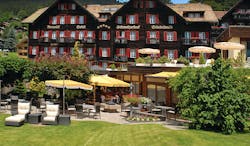
Romantik Hotel Schweizerhof Grindelwald is a 5-star chalet-style hotel with an abundance of character and immense sense of privacy, perfect for couples or families travelling together. The style, ambience, service and cuisine offer a glimpse of authentic Swiss life.
Standard double room

Hotel Wilden Mann is a 4-star boutique hotel in an excellent central location. With gourmet cuisine and stylish, comfortable accommodation, the 500 year-old hotel balances its historic and old-world style with elegance and modern facilities.
Classic double room

The Hotel Schweizerhof Luzern is a grand 5-star hotel with an imposing history situated on the shores of Lake Lucerne.
Classic double room
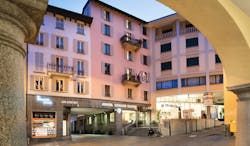
Hotel Lugano Dante is a comfortable, 4-star hotel in the centre of Lugano. This hotel serves as a comfortable and welcoming base from which to explore the town, lake and surrounding rural area.
Comfort double room

Hotel Schweizerhof St Moritz is a 4-star boutique hotel in a beautiful location on the mountain slopes, and is an excellent base for enjoying the scenery of Grisons and the Engadine. It offers stunning views, gourmet dining and exceptional service.
Corviglia double room
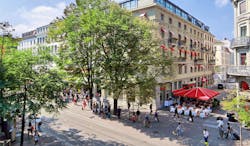
Hotel St Gotthard is a sophisticated 4-star hotel in an excellent central location. Haute cuisine and stylish, comfortable accommodation make this an excellent spot to recuperate after enjoying the cultural delights of Zurich.
Classic double room

The Romantik Hotel Europe in Zurich is a charming, boutique, family-run hotel with 39 rooms just two minutes’ walk from the shores of Lake Zurich and by the Opera House.
Classic double room

Hotel Storchen is an elegant and refined 5-star boutique hotel in a beautiful waterfront location. Delicious cuisine and luxurious accommodation make this an excellent spot to recuperate after enjoying the cultural and historical delights of Zurich.
Classic double room
We had the most amazing holiday. We loved the location, hotels, train travel and food. All the trains were well planned and on time.Mrs M, July 2018
Holiday price guide From about £3,380 per person based on two people sharing a double room and including for second class rail travel. First class supplement about £580 per person.
Holiday Code CHBR08
Call us on 01392 441245
Holiday prices
| Date | By air and rail | By rail throughout | ||
|---|---|---|---|---|
| 1 Jan 2024-31 Dec 2024 | £3,170 | £3,380 |
| Description | Date | By air and rail | By rail throughout | ||
|---|---|---|---|---|---|
| First class rail | 1 Jan 2024-31 Dec 2024 | £230 | £580 |
We had the most amazing holiday. We loved the location, hotels, train travel and food. All the trains were well planned and on time.Mrs M, July 2018
Holiday price guide From about £3,380 per person based on two people sharing a double room and including for second class rail travel. First class supplement about £580 per person.
From about
Holiday Code CHBR08
Our prices include
• Scheduled flights from the UK to Geneva and Zurich to the UK or rail travel from London to Switzerland and back via Paris (first class can be booked at a supplement)
• 8 days’ Swiss rail flexi pass (first class can be booked at a supplement)
• Journeys on the GoldenPass Line, the Gotthard Panorama, and the Bernina Express as described
• 2 nights’ bed and breakfast in a Superior Room at the Hotel Angleterre et Residence, Lausanne
• 2 nights’ bed and breakfast in a Standard double room at the Romantik Hotel Schweizerhof, Grindelwald
• 3 nights’ bed and breakfast in a Classic double room at the Wilden Mann, Lucerne
• 2 nights’ bed and breakfast in a Comfort double room at the Hotel Lugano Dante, Lugano
• 1 night’s bed and breakfast in in a Corviglia double room at the Hotel Schweizerhof, St Moritz
• 1 night’s bed and breakfast in a Classic double room at the Hotel St Gotthard, Zurich
Call us on 01392 441245
Luxury Swiss grand touring holiday by train visiting the lakes of Switzerland with journeys on the scenic iconic trains
About Bernese Oberland
An Expressions tailor-made holiday to the Bernese Oberland encompasses jagged Alpine peaks, over 800 lakes, dense forests of evergreen trees, and the chiming cowbells and rustic lodges of authentic towns and villages. The Bernese Oberland certainly captures the best of the Swiss natural landscape and culture. A stay here as part of a rail touring holiday is suited to those who seek an active sports holiday spent climbing, hiking, kayaking, and windsurfing, as well as those looking for a relaxing opportunity to soak up the sublime panoramas from the terrace of a gourmet restaurant or from the edge of a pool. Nestled into the steep valleys dusted with rich green vegetation, are beautiful chocolate box villages that border the many serene lakes. Mystical grottos have been carved into the rock by centuries of melting and re-freezing ice. Twisting rivers and streams have etched out their pathways down the mountainsides, flowing tranquilly in places and turbulent in others. Some of our favourite places in the Bernese Oberland include: Interlaken, poised majestically on the thin stretch of land between Lake Brienz and Lake Thun; Wengen, a picturesque village clustered between sheer rock faces; and Grindelwald, a village overlooked by harsh snowy peaks, the famous Jungfrau, and the Gletscherschucht glacial gorge.
Highlights of the Bernese Oberland
As a place of incredible natural beauty and the birthplace of skiing, the Bernese Oberland is a destination with a host of possibility for active and cultural activity. Essential to any visit to this region is the Jungfraujoch glacier, known as the Top of Europe, accessible via the narrow cog railway (Jungfraubahnen) up to the Jungfraujoch train station, standing at 3,454m above sea level. The Peak Walk suspension bridge, crossing between two peaks above Glacier 3000, reaches a thrilling 107m long and affords walkers magnificent views of the Matterhorn, the Mont Blanc Massif, the Eiger, the Monch, and Jungfrau. We also recommend visiting the area around Grindelwald, from which it is easiest to board a rail trip to Jungfraujoch, to see the Aletsch Glacier, the longest glacier in Europe, and begin a hike or mountain walk through the Lauterbrunnen Valley. The adventure sports centre of Interlaken is perfect for lake swimming, boat cruises, hiking, biking, horse-riding, and water sports. One of the area's quirkier landmarks is the Big Pintenfritz, Europe's longest toboggan run, reaching 15km in length and descending a total of 1,631m.
Festivals in the Bernese Oberland
The festivals and celebrations in the Bernese Oberland tend to revolve around the prominence of winter sports, such as the AUDI FIS Ski World Cup in Adelboden and the International Lauberhorn ski races in January; yet, during the summer and autumn months, there are many more that celebrate Swiss culture and tradition. Unique in the winter months, however, is the Belle Epoque week in Kandersteg, when the Belle Epoque era is embodied in a series of sporting and social events. In July and August, the Lake Thun Festival brings the peaceful lakeside alive with musicals and productions from all over the continent. In October, the AlpKultur Festival in Lenk im Simmental pays homage to all aspects of the region's traditions for a period of two weeks, with an Alpine festival, Hornussen tournaments (a type of Swiss ball game), and a range of interactive workshops.
Gastronomy in the Bernese Oberland
Like much of Switzerland, cheese makes up a large part of the regional food production. The Diemtigtal, in the west of the Bernese Oberland, is the largest Alpine cheese-making area in Switzerland, and so is the optimum place to visit an authentic mountain dairy. Many farms will serve breakfast or lunch alongside a cheese-tasting, or allow visitors to watch the cheese as it is made. The organic dairy on the Schwarzenberg Alp in the Wiriehorn area is one such as this. The AlpKultur Festival in Lenk in Simmental offers visitors the opportunity to briefly live life as a mountain farmer: helping with milking, cheese-making, looking after the animals, visiting farmsteads, and sleeping in the Alps.
Call us on 01392 441245
Luxury Swiss grand touring holiday by train visiting the lakes of Switzerland with journeys on the scenic iconic trains
About Lake Geneva
An Expressions tailor-made holiday to Lake Geneva is an ideal way to experience the beauty and serenity of this Swiss region. Marking a crescent-shaped segment of the France-Switzerland border, Lake Geneva is named after diplomatic, historic Geneva. French spa towns on the southern shore look across to the Swiss Riviera on the northern side, characterised by grand palatial buildings and hotels, promenades lined with trees, and tumbling fountains. Lake Geneva is popular for water sports and hiking holidays, as well as relaxing lakeside spa breaks; and, in the winter, it is close enough to the ski slopes to make a very laid-back skiing destination. Chic towns and villages sit behind rows of palm trees, basking in the Mediterranean climate, sheltering gourmet restaurants, luxury boutique shops, and a range of stunning Swiss hotels. Prestigious buildings, at the seat of European politics, call these idyllic towns home, adding a sense of importance to the atmosphere of the peaceful streets. There is perhaps nowhere more glamorous in Switzerland than Lake Geneva, and nowhere where the history and culture is so grand and visually captured in the buildings, parks, and gardens. With such close proximity to Geneva airport and the major railway lines, Lake Geneva is an excellent first or last stop on a touring holiday.
Highlights of Lake Geneva
Montreux, on the most eastern point of the lake is most famous for the Montreux Jazz Festival, which is held in international esteem. One of the most iconic sights, for both Switzerland and Montreux, is of Chillon Castle, jutting out on a rocky outcrop into the lake waters. This castle cannot be missed because of its fairy-tale beauty. You can also begin to explore the landscape around Montreux by rail. One railway takes you across Alpine meadows to Rochers-de-Naye at more than 2000m above sea level, from which you can sometimes see the Jet d'Eau in Geneva. The Swiss Chocolate Train, adorned with lavish Belle Epoque carriages, travels to the village of Gruyeres, where characterful old cobbled streets are lined with townhouses containing cafes and three museums. An imposing medieval castle sits at the top of the village. You can also reach the Maison Cailler on the Chocolate Train, where you learn about traditional Swiss chocolate-making and even make some of your own. The Vineyard Train (number S31) will take you through the 800 hectares that make up the Lavaux Terraced Vineyards from Vevey to Puidoux-Chexbres. The vineyards are the largest living cultural site in Switzerland and a recognised UNESCO World Heritage Site. Further west from the Lavaux Vineyards is Lausanne, home to the International Olympic Committee headquarters, but perhaps best known for simply being a particularly romantic and beautiful Swiss town. Gardens, promenades, and lakeside pathways ensure that your days here are as picturesque as they are cultural. At Lausanne's heart stands the Cathedral, believed to be one of Europe's most beautiful Gothic monuments. The purple and orange hues of its two main spires are visible throughout the town. It was originally built in the 12th and 13th centuries. In contrast with the Cathedral, immersed in the history of the cobbled Old Town, a new Olympic Museum has recently opened. Interactive displays illustrating the colourful history of the games are spread over three levels and include more than 1,000 objects and 150 screens. One of the highlights of the museum, however, is the Olympic Park. The artworks, sports sculptures, and beautiful patches of well-maintained nature provide a stunning setting for this modern cultural venture. From here, you can wander down the promenade at Ouchy, an area that is unrelentingly popular with residents. This promenade takes you to the Haldimand Tower, the Bellerive Swimming Pool, the Chateau d'Ouchy, and the port.
Cultural highlights of Lake Geneva
Any stay on Lake Geneva remains incomplete without a visit to the city that gives it its name. One of the key features of Geneva's cultural heritage is its place as the origin of fine watch-making. Workshops, boutiques, and museums all provide an insight into this prestigious craft. Even the Jet d'Eau fountain bears some connection, as it originally harnessed the power of the Rhone for the craftsmen of Geneva. Today, it acts as a captivating, animate monument to the skills, craft, and natural forces of the city. Geneva is also home to the Palais des Nations, the European headquarters of the UN. Guided tours take visitors through the building, which seems to blend geometric modern design with classical, palatial style. Geneva's Old Town, or Vieille-Villa, is the largest in Switzerland, laced with narrow alleyways and charming squares, and centred around the St Pierre Cathedral. 157 steps will take visitors to the top of the cathedral tower in order to appreciate the remarkable views over the fascinating jumble of unique townhouses. A very unique feature of Geneva is the Flower Clock in the Jardin Anglais. This precise and beautiful clock has the longest second hand in the world. Visitors interested in Swiss art and modern culture should spend an afternoon in the Quartier des Bains, wandering around the MAMCO and the Centre d'Art Contemporain before enjoying dinner in a chic bistro. Mediterranean Carouge is Switzerland's gateway to the south, with abundant Sardinian style. Finish your exploration with one of the four world-exclusive museums: the International Museum of the Red Cross and Red Crescent, Le Musee International de la Reforme, the Patek Philippe Museum, and the Bodmer Foundation Library and Museum.
Festivals in Lake Geneva
Much of the canton of Geneva's culture is built around a celebration of its history and traditions. Perhaps one of the liveliest celebrations is the Oktoberfest, though many more unusual festivals prove equally enjoyable. In the first two weeks of February, the Antigel Festival brings a variable programme of music, dance, and other performances to the less likely stages. In March, the International Geneva Motor Show, largest of its kind in Europe, unveils a range of new innovative designs at the Palexpo Exhibition Centre. Similarly, in April you can visit the International Exhibition of Inventions, New Techniques, and Products in the same venue. On specific dates of the year, usually mid-May, a selection of museums stay open for the whole night, an event that is also celebrated in a number of bars. Also in May is a Day of Open Wineries, where upwards of 90 wineries open their doors for free to wine-touring visitors. A charge of 5CHF at one winery will enable you to taste wines at every other winery for no further charge. In June and July, parks, gardens, and secluded outdoor spots on the lake shores play host to a range of live music and DJ sets at the Ecoutes au Vert Festival. In the middle of June each year, Lake Geneva is transformed into the largest sailing regatta in Europe, with over 500 boats competing. Geneva's largest music festival is the Geneva Music Festival in late June, specialising in a range of musical genres, and accompanied by an array of food stalls. Impossible to forget is the Montreux Jazz Festival, founded in 1967, that brings an eclectic range of performances to the lakeside stages, not limited to Jazz. The Cine Transat, hosted in one of Geneva's parks, features a series of French and English films. The Prelude to the Geneva Festival and the Geneva Festival itself take place from the middle of July until the first week of August and are widely believed to be the highlight of summer in the region. Carnival rides, concerts, stalls with Swiss delicacies and street food, parades, and variety performances take over the lake shores, topped off with unique firework displays each and every night. The Festival de la Batie from the end of August to mid-September exhibits the works of many local artists from a range of disciplines in Batie Park. The Nuit des Bains sees several galleries in the Quartier des Bains open their doors for free. For a taste of Geneva's history, watch l'Escalade in the Old Town in the second week of December, which commemorates that defence of the city against the Duke of Savoy in 1602.
Gastronomy in Lake Geneva
With over 1,000 restaurants, Geneva is recognised as the capital of culinary delicacies in Switzerland. For decadent dining, choose one of the hotels that line the lake shores; for foreign cuisine, head to the Paquis district; for traditional Swiss dishes, dine in Geneva's Old Town; for Italian restaurants and French cafes, go to Eaux Vives; and for experimental, chic restaurants, eat in Carouge. Some ingredients to look out for in particular are cheeses from Gruyere, oil from Severy, charcuterie, perch, fera, char, and leeks. Vaud, the region in which Lake Geneva sits, is Switzerland's largest wine-growing region, and the most prominent grapes are Chasselas, Pinot Noir, and Gamay. You may also discover some Tartiflette, which originated over the French border in Haute-Savoie, made with Reblocohon cheese.
Call us on 01392 441245
Luxury Swiss grand touring holiday by train visiting the lakes of Switzerland with journeys on the scenic iconic trains
About Lake Lucerne
An Expressions tailor-made holiday to Lake Lucerne allows travellers to be immersed in history, folklore, and bustling modern culture. Lake Lucerne brings together everything that makes Switzerland in summer so special. The city of Lucerne itself is one of the most beautiful cities in the world. White-walled, tiled-roof townhouses crowd together on the water's edge; bridges on stilts take visitors from one side of the river to the other; and the high original rampart wall is visible in the distance. Outside the city, you are free to enjoy the Alpine panoramas from a boat, or from one of the hiking trails that score the mountainsides. Thrilling extreme sports can be enjoyed alongside serene rounds of golf in quilted green valleys, or hours can be whiled away in one of the smaller towns and villages around the lakeside. Further inland, you can uncover villages virtually untouched by commercial tourism that seem to be preserved in a bubble of authenticity. Any stay in the Lake Lucerne region will be one packed full of stunning views, nature excursions, and exhilarating hours on the mountainsides or on the water.
Highlights of Lake Lucerne
Begin your exploration of the Lake Lucerne Region with the famous city itself. To get your bearings, wander along the river or lakeside, stopping first at the Chapel Bridge, Lucerne's main landmark and the most photographed monument in Switzerland. This bridge gets its name from St Peter's Chapel, which stands nearby, and was built in the early 14th century, making it a true testament to its ingenious structure. The Water Tower that stands partway along the bridge once formed part of the city walls, and has served a number of functions, including that of an archive, prison, and torture chamber. Also part of the city's fortifications is the Spreuer Bridge, which, again, stretches across the Reuss, but with an unusual ochre design characterised by the small red turrets attached above the bridge's supports. The so-called ‘Water Spike,' which regulates the water level in the Reuss River, is recognised for being a truly unique sight, due to the specificities of its engineering. For more stunning, historical structures, visit the 17th century Jesuit Church, with its grand, regal Baroque façade, which was the first large sacral church to be built in Switzerland. High above the city is the Musegg Wall. Built in the late 14th century, the wall remains remarkably well preserved, as do the nine towers, of which three are open to the public. For a taste of traditional Swiss life, visit one of the historical squares hidden down the city streets and enjoy a light lunch or drink in one of the cafes. The Town Hall and Pfistern Guildhall, which is artfully painted, are situated on the Kornmarkt Square; the Hirschenplatz Square is named after an inn that dates back to medieval times; and the Weinmarkt Square is the site on which Lucerne swore its federal oath with Schwyz, Uri, and Unterwalden in the early 14th century.
Cultural highlights of Lake Lucerne
Lucerne is home to a variety of museums and galleries, including the KKL Luzern, the Rosengart Collection of works by Picasso and Klee, the Wagner Museum in Tribschen, and the most well-known of them all, the Swiss Museum of Transport. Once you have explored Lucerne's streets, restaurants, and shops, finish your tour with a visit to the Dying Lion of Lucerne. Commemorating the deaths of the Swiss mercenaries at the attack on the Tuileries at the end of the 18th century, this monument is one of the most moving in Europe. Follow the northern shore of the lake to the picturesque villages of Weggis and Vitznau. Weggis is recognisable from the water by the red-topped church spire at the village's highest point. The scattered houses in both are surrounded by green lawns, clusters of evergreen trees, and gently rising slopes. The Wilhelm Tell Express will take you by boat from Lucerne across the river to Fluelen, passing the iconic spots that feature in the legend of Wilhelm Tell, the best known folk character in Switzerland and the Swiss National Hero of Liberty. The meadows in Rutli, for example, are the setting of Friedrich Schiller's recounting of Tell's tale, and Tell's Chapel in Sisikon is built upon Tell's Slab, where he famously jumped from the bailiff's boat before pushing them back into the storm. Further inland, in the neighbouring cantons that claim sections of Lake Lucerne's shores, are several picturesque towns and villages with their own individual character. The town of Schwyz, in the canton of the same name, provides both a valuable connection with the cities and towns to the east of Lake Lucerne and an equally valuable insight into the traditions and atmospheres of small towns that have retained much of their historical air. The most popular and interesting part of this town, which is mainly characterised by its peaceful streets of chalet-style buildings, is the Hauptplatz. Here, you can admire the painted façade of the Town Hall while enjoying some food at the restaurant of the Hotel Wysses Rossli. Those looking to explore the landscape on foot or by cable car should head towards the two main peaks of the Lucerne area: Pilatus and Rigi. The former was once reputedly the home of a dragon and is now believed to be the final resting place of Pontius Pilatus, but most remarkable are the views across 73 Alpine peaks that can be appreciated from the top. Rigi is known as Queen of the Mountains, from the summit of which you can see 13 lakes, the entire Swiss Mittelland, and the borders into Germany and France. A cable car up to Rigi can be taken from Weggis. To enjoy the scenery by rail, take the funicular railway from Stoos to Fronalpstock or vice versa, the track of which is the world's steepest. Once on the mountainsides, you are at your leisure to embark on cycling tours and hiking tours to unveil the waterfalls and mountain streams, to take a once-in-a-lifetime skydiving or paragliding trip, or to take your time with a round of golf. The range of places and activities that surround Lake Lucerne is given its diversity by the stunning landscape, and by the coming together of so many cantons, each with their own unique culture. We would recommend staying long enough to try a little of everything to truly make the most of this fantastic and inspiring region.
Festivals in Lake Lucerne
Lucerne prides itself on being a city of festivals, a title that it lives up to through its blend of music, food, and theatrical celebrations. The biggest of these is without a doubt the Lucerne Carnival. Beginning on Fat Thursday before Lent begins, the carnival features three massive parades with masks, costumes, bonfires, and displays by the various societies in the area. Music festivals in Lucerne also include the World Band Festival at the end of September, the Lucerne Blues Festival at the beginning of November, the Lucerne Festival at the Piano in mid to late November, the two Lucerne Festivals (at Easter and in summer) which focus on classical music, and the Blue Balls music and art festival in late July. Sports enthusiasts might want to plan their visit in time with the Lucerne Regatta, on the 7th to 9th July 2017, and the Athletics Meeting, also in July.
Gastronomy in Lake Lucerne
The food around Lake Lucerne, like its history, is made diverse by the numerous cantons. Visitors can enjoy high-class gourmet food in stylish modern restaurants, or can enjoy traditional delicacies in smaller, family-run establishments. One example of a popular local dish is the Lozarner Churgelipastete, which comprises of veal and mushrooms cooked inside a puff-pastry casing. Those with a sweet tooth might wish to try the pear bread. To try some Swiss Alpine cheese, we would recommend ordering either the raclette or the fondue, as these are possibly the most typically Swiss dishes available. Finish off your culinary tour of Lucerne with some of the famous Swiss chocolate made by a local chocolatier.
Call us on 01392 441245
Luxury Swiss grand touring holiday by train visiting the lakes of Switzerland with journeys on the scenic iconic trains
About Saanenland
An Expressions tailor-made holiday to Saanenland allows for exploration of this beautiful and peaceful yet bustling Swiss region. Considered a part of the Bernese Oberland, the Saanenland is rich enough to be a region in its own right. Central Gstaad offers a unique and authentic Swiss holiday experience, with quirky shops and restaurants to suit all tastes. Its many luxury chalets remain popular with A-List celebrities. Surrounding Gstaad are nine other villages, such as Schonried, Zweisimmen, Saanen, and Saanenmoser, which prove to be continually popular as winter sports destinations, particularly with skiers. In the summer, however, the Saanenland offers a wealth of exploratory and sporting diversity. Priding itself on being a haven of wellbeing, the Saanenland offers a taste of idyllic nature, whilst remaining one of Switzerland's chicest locations.
Highlights of Saanenland
The Saanenland is based in the convergence of five valleys. Streams, lakes, forests, and verdant slopes therefore provide a 360 degree backdrop to your stay here. The isolated and little-known Lauenensee, for example, is a bubble of peace and tranquillity, with pathways around the lake shores that lead up to a waterfall that crashes between jutting rocks on its way down the mountainside. In the winter, the lake freezes over, and there is every chance you may be the first to leave your footprints in the snow. Gstaad is perhaps what makes the Saanenland so well-known and so deserving of its own individual place as a region in our overview of Switzerland. The traffic-free main promenade is lined with perfectly maintained, authentic Swiss chalets, complete with dark wood peaked roofs, shuttered windows, and balconies. These chalets contain intriguing boutique shops and some of Gstaad's 100 restaurants, which serve anything from Swiss raclette to gourmet, refined cuisine. In the landscape around Gstaad lie a huge range of summer sports opportunities. More than 300km of hiking paths take you up and around the mountains and deep into the valleys. Mountain-biking, paragliding, and golf also remain continually popular with seasonal guests. Schonried hosts a famous toboggan run, while exhilarating downhill scooter rides can be enjoyed from Wispile to Gstaad or Sparenmoos to Zweisimmen. On the River Saane, you can wrestle the torrent on a raft or in a canoe. Schonried, on the so-called ‘sun terrace' above Gstaad, is one neighbouring village that is of particular interest. Schonried is an excellent starting point for many hikes or long walks, due to its sublime scenery and many cableways and high-altitude railways. The picture-postcard village of Zweisimmen is known as the Gateway to the Saanenland. Most notably, however, it is an important station on the iconic route of the GoldenPass Line, and the railway line that links the Bernese Oberland to Montreux. You may wish to visit Zweisimmen for the Rinderberg cable car, which takes you up to one of the largest ski areas in the Saanenland in winter, and up to an intricate network of walking routes in the summer. Various themed trails take you through the different elements of the local culture, such as around the authentic farmhouses with their carved murals, or high up in the mountaintops. There are ten villages in total in the Saanenland, each of which is charming in its own right. Should you have time, we would not discourage visiting as many of these as possible to admire the scenery from multiple angles.
Festivals in the Saanenland
A lesser-known highlight of the area's winter sports opportunities is the Zweisimmen Snow Games in January, featuring a waterslide through the Rinderberg water, ski-cross races, downhill mountain biking, and freestyle parkour. February and March in Gstaad are made all the more enchanting by the Sommets Musicaux de Gstaad, a small classical music festival. The summer sees two large tennis tournaments come to Gstaad: the J. Safra Sarasin Swiss Open Gstaad, and the Ladies Championship Gstaad. The Davidoff Saveurs Gstaad celebrates authentic local cuisine and wine in July. For more traditional celebrations, attend the Suufsunntig, an Alpine festival from July to August hosted on the nearby mountains. Also in the summer, from July to September, is the Gstaad Menuhin Festival, which honours the violinist and conductor after which it was named, with numerous performances of haunting classical music. The Hublot Polo Gold Cup Gstaad in August sees jockeys from all over the world racing Arab horses. Something a little different can be enjoyed at the Country Night Gstaad in September. Across the border into the canton of Vaud is Chateau-d'Oex, which hosts the International Balloon Festival, the most important balloon event in the Alps.
Gastronomy in the Saanenland
As in much of Switzerland, cheese plays an integral part in the local gastronomy of Saanenland. In Chateau-d'Oex and Rougemont, be sure to try the Etivaz cheese, which is made in the cauldrons of Alpine huts. In a quaint gourmet restaurant in Gstaad or on the lush rolling pastures of Schonried, try the fondue or raclette in the environment in which it was intended to be eaten. Local farms, particularly dairy farms, offer breakfast, lunch, and dinner service, with the opportunity to try some of their homemade produce and watch as the cheese is made.
Call us on 01392 441245
Luxury Swiss grand touring holiday by train visiting the lakes of Switzerland with journeys on the scenic iconic trains
About Ticino
An Expressions tailor-made holiday to Ticino allows travellers to witness the sheer diversity of Switzerland as a country. Hailed as having a Mediterranean climate, Ticino is Switzerland's most southerly region. Italianate towns, influenced by the proximity of the Italian border, provide a wholly different culture and atmosphere to the Bernese Oberland, the Saanenland, and other central and northern regions. A smattering of small lakes mark the upper boundary of Ticino, but it is Lake Maggiore and Lake Lugano that dominate the south, prompting many of the long, straight valleys that lead into Italy. The River Ticino winds its way down from its source on the Ticino border, meeting dams, lakes, and trickling and tumbling waterfalls on its way. Palm trees line the lakesides, medieval Italian castles form the centre-points of towns, and colourful, higgledy-piggledy houses look out across the water or from their tiered position on the steep mountainside. Communities here seem to effortlessly blend the feel of southern coastal towns with the rural authenticity of the mountain villages of central Switzerland.
Highlights of Ticino
Two of the main cities in Ticino lie quite close together in the south of the region: Locarno and Lugano. On the banks of Lake Maggiore, Locarno is rich with cultural treasure. Visit the 17th century Church of St Anthony, the 16th century Church of San Francesco, the mid-17th century New Church, or the late 15th century Sanctuary of the Madonna del Sasso to begin your tour of Locarno's beautiful and historic sites. Perhaps most noteworthy, however, is the Visconti Castle, in which there is a permanent exhibition of Roman glass. On Thursdays a market is held in the centre of the town, which always makes for an excellent place to enjoy Locarno at its liveliest, as well as to pick up a few delicacies. Venture outside Locarno to climb the Cadada Cimetta, from the top of which you can see both the Valais High Alps and Lake Maggiore, the highest and lowest points in Switzerland. Follow the paths of the Magic Valley or the Verzasca Valley to witness the turquoise-green, crystal-clear waters that flow there. For a more leisurely day out, enjoy a boat cruise on Lake Maggiore. As you leave Locarno and head west down the valley towards Italy, you will see the rocky gorges that prove so popular with cliff divers. Eerie tunnels and caverns have been carved out over time, providing ethereal little spots to stop off on your travels.
Cultural highlights of Ticino
East of Locarno is Bellinzona, a town remarkable in that it is the most Italianate town in Switzerland and capital of Ticino. The central medieval castle and its two neighbours are among Switzerland's best preserved, coming together to form a picturesque UNESCO World Heritage Site. The ramparts of the central castle run alongside the vineyards within, with lush grass carpeting the fortified walls. North of Locarno, you will come across Tegna, the site of some interesting prehistoric ruins. Continue along this route towards the Italian border on the Centovalli Express to discover the old wine press in the village of Cavigliano, the museum and cableway in Intragna, the cable car up to the solitary, traffic-free hamlet of Rasa from Verdasio, and finally, across the Italian border to Re, where the stunning, yet imposing, Sanctuary of the Madonna of the Blood stands on the very edge of a dramatic cliff. In eastern Ticino is Biasca, a town where a waterfall cascades down the mountainsides, under bridges and over rocks that have been smoothed by time. Towns and villages such as Airolo, Lavizzara, Acquarossa, Blenio, and Brione all offer alternative views on this beautiful region. Any visit to Ticino is incomplete without a few hours spent in Lugano. Famous for its eponymous lake, San Salvatore Mountain, and Monte Bre, Lugano is a quintessentially ‘Ticino’ town. Take the funicular railway from Casserate as high as possible up Monte Bre to witness the phenomenal panoramas and enjoy the traditional Swiss rail experience.
Festivals in Ticino
As with much of Switzerland, there is a high focus on dairy products in both the regional dishes and their self-identification. To appreciate Swiss dairy products in Ticino, head to Ambri Quinto in the Leventina Valley at the end of September to enjoy the Agriculture and Cheese Fair. The first weekend in October brings with it a celebration of autumn. In Lugano, this autumn festival focuses on local products, folkloric music, and small dramatic shows. In Ascona, the autumn festival celebrates the versatile chestnut, with jams, cakes, cheese dishes, and entertaining concerts. Ascona's unique carnival is celebrated on Mardi Gras on the lake promenade. In Muralto on the second Sunday of March there is a fish festival beside the water, involving a fishing contest, music, games, and food stalls. Beside the smooth rocks of Solduno, on St Joseph's Day in March, the streets are filled with the smell of the speciality Tortelli, a fritter whose recipe is strictly guarded.
Gastronomy in Ticino
The varied and delicious specialities of Ticino may very well be the highlight of your trip, influenced by hearty Swiss cuisine, as well as Italy's Mediterranean flavours. One particular feature of dining here are the ‘grotto' restaurants. Usually housed in picturesque stone farmhouses, with abundant flower boxes, shuttered windows, and vast terraces canopied by views on which customers eat fresh, home-cooked food. Popular so-called ‘slow foods' include farina bona flour, cicitt sausages, Zincarlin cheese and shortbread biscuits. At the heart of many dishes you may come across are polenta and Merlot wine, which can also be sampled at a local winery. Originally cooked in a large cauldron like porridge, polenta is now best served alongside braised beef. Before leaving Switzerland, ensure you sample some of the world-famous fondue.
Call us on 01392 441245
Luxury Swiss grand touring holiday by train visiting the lakes of Switzerland with journeys on the scenic iconic trains
About Zurich
Zurich is a city that adapts to and flourishes in every season. In the summer, it is a cosmopolitan haven of designer boutiques, riverside pavement cafes, 50 museums, and over 100 galleries; and, in the winter, the streets of grand townhouses, churches, and palaces are transformed into a veritable winter wonderland. Step outside the city and you are immediately cast back into rural, Alpine Switzerland as the landscape becomes more dramatic and Lake Zurich dominates the plethora of natural interest sites. Towns such as Winterthur and Uster are home to their own range of traditions and their own character, with architecture and cuisine that reflects both the proximity of the German border and a proud Swiss national identity. With such close proximity to Zurich airport and the major railway lines, Zurich is an excellent first or last stop on a touring holiday.
Highlights of Zurich
The capital of the German-speaking canton of Zurich is the internationally-renowned historic city of Zurich. The perfect place to acclimatise to the Swiss way of life, there is much cultural discovery to be done. Perhaps begin with the waters of Lake Zurich and the River Limmat, taking a scenic boat cruise, or hiring a dingy for a more hands-on approach. Pedal boats offer a happy medium, and the lakefront Badi-Bars are beautifully situated for an evening drink afterwards. To witness the beauty of the city from above, climb to the top of the Karlsturm, one of the Grossmunster Church's two iconic towers. On the banks of the River Limmat is Schipfe, Zurich's oldest district. It was once the headquarters of the silk industry, and home to many tranquil bathhouses and the workshops of boat-builders; now, however, it has a very serene atmosphere that attracts artisans as well as visitors looking for peaceful strolls down quaint streets. The Lindenhof District was the site of a Roman fort in the 4th century, and Charlemagne's grandson's palace in the 9th century. Today, it is a popular meeting place for Zurich's residents. For a sweeping view of Zurich's Old Town, walk along the promenade in the Niederdorf District. Here, shops are hidden down narrow alleyways, old-fashioned grocery stores sell the local produce, and the views of grand stone buildings are topped off by the Grossmunster's towers. Everywhere in Zurich, however, there are pockets of outstanding beauty, be it beside the 1,200 fountains of drinkable water, on the historic Little Red Train, or Polybahn, that takes you up to the Polyterrasse, or on the world's most luxurious shopping mile, the Bahnhofstrasse.
Cultural highlights of Zurich
Informative cultural experiences can be had at a number of locations around the city. The Kunsthaus Art Museum exhibits a range of permanent and temporary displays by artists of international and local acclaim. The Museum Rietberg exhibits a range of non-European artistic and cult objects. The Arthouse Cinemas are known throughout Europe for the rare opportunity they provide to view independent films in a cinema setting. For innovative modern art, visit the Migros Museum or the Kunsthalle at Lauenbrau-Areal. More unique artistic ventures can be found at the Bruno Weber Park and Cabaret Voltaire, the birthplace of Dadaism. The so-called ‘Home Mountain,' or Uetliberg, is beautifully quilted in rich, dense forest and looks out across the city rooftops below and the blue waters of Lake Zurich. The Uetliberg Railway takes you up to the top of the mountain in no time at all, or it is possible to walk to the summit in less than two hours. Venturing outside the city, you may want to spend a day enjoying the natural scenery. At Rapperswil on Lake Zurich you can step out to the lake's centre to take in the 360 degree panoramic views. Also only a short distance away by rail is the majestic Rhine Falls, the largest plain waterfall in Europe. Stretching 150m across, the sight of the tumbling, crashing water is fantastic and well-worth the train ride. Kyburg Castle, once the home of the Counts of Kyburg and then the Habsburgs, is a magnificent and eerie insight into medieval life, torture, food, and the illustrious heritage of the area. An unseal, irregular pentagon, the castle fits perfectly onto the small hill on which it sits, cradling a picturesque courtyard. At night, the stone walls and square-pyramidal roofs are atmospherically lit from the ground with golden light. The museum housed within introduces visitors to everything medieval, from military fashion to the produce of the authentic vegetable garden. The city of Winterthur, though considerably smaller than Zurich, will be a highlight of your trip. Besides its 17 museums, including the Oskar Reinhart ‘Am Romerholz’ collection of 14th to 20th century art, Winterthur has the largest pedestrianised Old Town in Switzerland. Mansions line the petite squares, and the City Church with its red-topped towers and the Fisher Maiden's Fountain give it exceptional character. The Town Hall Passage remains a famous and popular attraction. Winterthur is also home to a prestigious Centre for Photography, a Casino Theatre, and the Swiss Science Centre Technorama. To end your day in Winterthur, or your stay in the Zurich Region, locate your favourite of the garden city's parks to sit back and enjoy the late afternoon sun.
Festivals in Zurich
In Zurich, the festivals and cultural events generally celebrate modern, artistic accomplishments, spotlighting international, not just local, stars. The Zurich Film Festival, for example, runs from the 22 September to the 2 October, and the Zurcher Theater Spektakel runs from August 13 to September 4. Winterthur plays host to the International Short Film Festival, the Winterthurer Musikfestwochen, and the Afro-Pfingsten. One alternative festival is the Dorflifascht in the Niededorf District at the end of August, when music, markets, food stalls, and shows take over the streets and squares. The Food Zurich festival will be held annually at the end of September, as of 2016, featuring fine, gourmet food sold at stalls by local restaurants and producers. Each year, the Manifesta takes on popular cultural and political issues, and deals with them through art over a period of up to 100 days.
Gastronomy in Zurich
The cuisine in Zurich is very typically Swiss, meaning that trying the chocolate, particularly by Lindt, Laderach, and Vollenweider is a must, along with the Luxemburgerli macaroons. A key dish in Zurich is the Zurcher Geschnetzeltes, a veal and mushroom ragout with kidney and sweetbreads that originated in the city. Rosti, fondue, and raclette remain popular this far northeast, as does the traditional Stubli. For a very traditional Swiss meal, head out to Rapperswil one evening. On your travels through Zurich, however, you will also come across a number of innovative restaurants serving creative cuisine, such as classic Swiss dishes using meat substitutes such as Tofu, or in unusual locations, such as the interior of an old mill.

